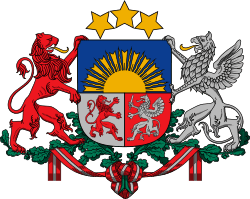Latvian European Union membership referendum, 2003
 |
| This article is part of a series on the politics and government of Latvia |
| Foreign relations |
A referendum on European Union membership was held in Latvia on 20 September 2003.[1] Latvia was the last of the states which would join the EU in 2004 to hold a referendum on the issue. Just over two-thirds of voters voted Yes and Latvia joined the EU on 1 May 2004.
Background
Latvia was invited to begin negotiations to join the EU in 1999 and was formally invited to join at a summit in Copenhagen in December 2002. On the 27 December 2002 the Latvian government decided to hold a referendum on the 20 September 2003 on joining the EU.[2] In May 2003 the Parliament of Latvia amended the Constitution of Latvia to allow referendums on international matters.[3] Campaigning began on 5 May 2003.[4]
Referendum question
The question voted on in the referendum was:
Do you support the membership of Latvia in the European Union?[5]
Campaign
Latvia was seen as being one of the skeptical countries on joining the European Union but polls in the years before the referendum consistently showing an advantage for supporters of EU accession. Only one opinion poll in February 2002 showed opponents of membership in the lead. Support for membership rose during the campaign with over 50% expected to support membership as the referendum neared.[3]
Supporters of joining the EU included the coalition government and the business community. They argued that this would give access to EU markets and development aid. They also stressed that membership would provide protection from pressure from Russia. In the last few weeks the Yes campaign launched an advertising campaign with the slogan "Don’t stay aside!”[6]
The No campaign argued that Latvia should not surrender the sovereignty they had recently gained from the Soviet Union. They also suggested that Latvia would suffer economically as the poorest of the candidate countries. Generally opposition was higher among ethnic Russians and in the poorest regions of Latvia.[3][7]
Results

The results saw the highest turnout of any of the Eastern European countries holding referendums in 2003 and well above the 35% required in order to make the referendum binding.[4] The Yes vote was ahead in 30 of the 34 electoral districts with the highest Yes vote among Latvians abroad with over 90% supporting membership. The highest No vote was in the poorer east of Latvia, especially where there were significant numbers of ethnic Russians.[3]
| Choice | Votes | % |
|---|---|---|
| For | 676,700 | 67.5 |
| Against | 325,980 | 32.5 |
| Invalid/blank votes | 7,787 | – |
| Total | 1,010,467 | 100 |
| Registered voters/turnout | 1,414,133 | 71.5 |
| Source: Nohlen & Stöver | ||
Reactions
The Prime Minister of Latvia, Einars Repše, celebrated the result with 2,000 young people in Riga. He put a blue EU t-shirt on and said that "Latvians understand this is a decisive moment!"[8] The President of Latvia, Vaira Vīķe-Freiberga, described the result as "wiping out forever the divisions on the map of Europe that the odious Molotov-Ribbentrop Pact of 1939 placed here."[9]
References
- ↑ Nohlen, D & Stöver, P (2010) Elections in Europe: A data handbook, p1122 ISBN 978-3-8329-5609-7
- ↑ "Latvia to hold EU referendum on 20 September 2003". NewsLibrary.com. 27 December 2002. Retrieved 2008-02-17.
- 1 2 3 4 "Referendum briefing No 10: Latvia's EU accession referendum, 20 September 2003" (PDF). European Parties Elections and Referendums Network. Retrieved 2008-02-17.
- 1 2 "Latvia: Saying 'I Do' to Europe". EurActiv.com. 2003-09-23. Retrieved 2008-02-17.
- ↑ "World/Election Watch". CNN. Retrieved 2008-02-17.
- ↑ "Latvians set to vote to EU entry". CNN. 2003-09-19. Retrieved 2008-02-17.
- ↑ Grammaticas, Damian (2003-09-20). "Latvia wrestles with EU dream". BBC Online. Retrieved 2008-02-17.
- ↑ "Latvia in decisive 'yes' to EU". CNN. 2003-09-21. Archived from the original on 8 October 2003. Retrieved 2008-02-17.
- ↑ Reuters, Riga (2003-09-22). "Latvian yes completes EU sweep". London: Guardian Unlimited. Retrieved 2008-02-17.